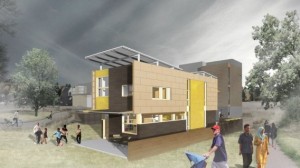Coming to you live this morning from the Built Green Conference in gorgeous Mukilteo. We are at the Rosehill Community Center above the ferry terminal.
The structure this year is breakout sessions bookending a keynote speech at lunch. There also is an expo where we can meet vendors and other stakeholder sin energy efficiency and green homes. It is hard to decide which session to go to. I picked the one that best matches my personal interests and professional role as a real estate broker.
So I am in the Fowler Room in “Transforming Markets: Community Power Works, 20/20 Home Refit Challenge, and Community Energy Efficiency Programs.”
This is a panel of multiple perspectives, including building science, outreach, marketing, and workforce development.
Jason Lear (Batt+Lear)
Andrea Petzel (City of Seattle Department of Planning and Development)
Ruth Bell (Community Power Works)
Dan Wildenhaus (Senior Building Science Specialist for Fluid Market Strategies)
Topics this session
Community Energy Efficiency Program
Do Energy Efficiency Programs transform markets?
Have local programs transformed our market?
How do we know?
What’s next?
Interestingly enough, I was an early participant in the Community Power Works program, before it reached its current iteration of providing a $95 energy assessment. A volunteer came to my home and talked about energy efficiency and how to cut your personal energy use. Low hanging fruit (one of the easy. low cost things you can do) included replacing all of our existing light bulbs with CFL bulbs. This was about two years ago. I had not changed out the light bulbs from when we bought the townhome as new construction in 2007. It is a 3-Star Built Green Certified home in the Built Green Certified Community of High Point in West Seattle. Besides energy efficiency, changing to a lower usage bulb makes your home more comfortable. All of those incandescent bulbs put out a lot of heat.
There are a number of measuring tools that are being utilized to show the results of the Community Power Works retrofits. Over 500 homes have been completed, with over 240 in the pipeline now. The gal si to reduce energy use by at least 15%. Only one home has not met that goa, anf there are some “audacious” homes that are saving 50-60% in energy use on their utility bills.
Building science
Rather than write all new specs, they use Department of Commerce specifications for building performance.
Reducing air leakage in a home (insulation)- leaky recessed lighting fixtures increases heat loss/gain, and can cause ice dam problems.
Most often performed corrective action taken in homes in the program:
Air sealing
Attic insulation
Wall insulation
Floor insulation
uct sealing
Duct insulation
Measurement used to be in carbon savings. Most people couldn’t understand it so it was changed to energy savings. Quality assurance has to be evaluate frequently so course corrections can be made. Programs like this leverage current training to bolster both new and existing workers and create not just jobs but quality companies.
Who are the customers/
Income between $50-$150k. There is a significant drop off in the higher income brackets, perhaps these flks don’t consider government programs for tem. There also is a low number of households with people of color. Perhaps there is a language barrier or translation problem that needs to be increased. More outreach to lower income communities. There are cultural liasons speaking about 12 languages
33% of households have children in the home
Most homes were built before 1959.
Average cost of upgrade $14,500
Average CPW rebate: $2,600. (18%)
Average utility rebates: $700 (5%)
Customers with CPW loans: 25%
Washigton State University (WSU) is a big participant in the program, helping with surveys of homeowners after they have participated in the program.
Now what? (Jason Lear)
20/20 Home Refit Challenge: 20,000 ohomes with 20% energy savings
Program participants get: Special financing and the market value of a Buitl Green Certification + Energy Score
Puget Sound Cooperative Credit Union (PSCCU) has developed a special home equity loan for homeowners who participate in the program.
“Puget Sound Cooperative Credit Union understands the challenge in affording energy-efficient alternatives for your home. We’re here to help with our Energy Smart Loans. Our loan products cover everything from heating and cooling, hot water tanks, gas conversions, windows and even renewable energy like SOLAR! Need to do some prescriptive measures before you can make your home more efficient? We can usually help with that as well.”
What is the future of Community Power Works?
Under negotiations now withs stakeholders trying to get interest gauged from utilities and assessing market need. By Jan or Feb 2013 there may be an extension to the program (but no new money coming in).
This is a working blog post and will be updated as more information becomes available to flesh out the details of this session.


 Martha Rose (
Martha Rose ( I met Martha Rose a few years ago when touring one of her sustainable home developments in the Shoreline area just north of the Seattle city limits. It was called Fish Singer Place and it was a renovated original home and three new homes built on the original property – a very large lot.
I met Martha Rose a few years ago when touring one of her sustainable home developments in the Shoreline area just north of the Seattle city limits. It was called Fish Singer Place and it was a renovated original home and three new homes built on the original property – a very large lot.